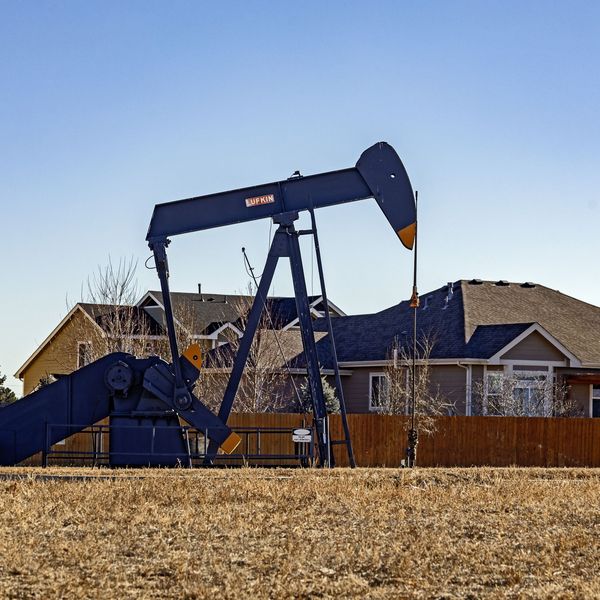SCOTUS Further Weakens EPA Power to Regulate Greenhouse Gases
Ruling issued Monday cuts back already 'soft' regulatory measures under the Clean Air Act
The U.S. Supreme Court on Monday placed further limits on the Environmental Protection Agency's already-modest power to regulate power plant and factory emissions of greenhouse gases.
The Court ruled in a 2007 case that greenhouse gases emitted by new motor vehicles constitute pollution that is subject to regulation under the Clean Air Act. Under this act, any polluter that emits more than 250 tons of a recognized pollutant must acquire a permit before expanding or modernizing.
The EPA interpreted the 2007 ruling to mean that greenhouse gases emitted by stationary facilities--including power plants and factories--are also subject to regulation under the Clean Air Act. The agency raised the threshold for regulation of stationary facilities to 100,000 tons of carbon dioxide a year--a move it said was designed to avoid excessive permitting processes, given how prevalent CO2 pollution is.
The Court's ruling on Monday determined that, contrary to the EPA's interpretation, the 2007 ruling on automobiles does not automatically trigger regulations for stationary greenhouse gas emitters. Furthermore, the court ruled that the EPA did not have the authority to rewrite this threshold without congressional approval.
As a result, the EPA cannot require stationary polluters to obtain permits solely on the basis of their production of carbon pollution. However, if a permit was already required for other pollutants, the EPA can force stationary polluters to employ certain technologies to control greenhouse gas emissions.
Yet, according to Bill Snape, senior counsel for the Center for Biological Diversity, these permits are themselves weak regulatory measures. "Most of the permits I looked at were very soft and relatively easy permits to comply with," Snape told Common Dreams. "None of them had hard pollution standard triggers, and they weren't forcing technological changes, just requiring that existing technology work as efficiently as possible."
The ruling--the result of industry, state, and Chamber of Commerce challenges to the EPA--will affect a minority of stationary facilities, as most are so big that they will still be subject to EPA regulation due to non-greenhouse gas emissions. Nonetheless, critics are concerned that cuts to already soft regulations do not bode well for an aggressive plan to combat climate change.
Justice Breyer wrote in his dissenting opinion, "What sense does it make to read the Act as generally granting the EPA the authority to regulate greenhouse gas emissions and then to read it as denying that power with respect to the programs for large stationary sources at issue here?"
Snape said he views the decision as "half disappointing" and noted that it sidesteps the question of "whether the EPA ought to be setting ambient airt quality standards for greenhouse pollutants." He said, "This remains an essential issue: how clean do we want to get our atmosphere?"
Furthermore, the decision highlights continued climate change denial-ism among Supreme Court Justices. Justices Samuel Alito and Clarence Thomas wrote in an opinion that they would have preferred to leave greenhouse gases completely exempt, writing that the Clean Air Act "is simply not suited for use with respect to greenhouse gases." According to Snape, "Yet again you're seeing the Supreme Court divided on how to deal with global warming."
It is not immediately clear how the court ruling will impact the Obama administration's climate plan, announced earlier this month, to cut carbon emissions from U.S. power plants by 30 percent from 2005 levels by the year 2030.
_____________________
An Urgent Message From Our Co-Founder
Dear Common Dreams reader, The U.S. is on a fast track to authoritarianism like nothing I've ever seen. Meanwhile, corporate news outlets are utterly capitulating to Trump, twisting their coverage to avoid drawing his ire while lining up to stuff cash in his pockets. That's why I believe that Common Dreams is doing the best and most consequential reporting that we've ever done. Our small but mighty team is a progressive reporting powerhouse, covering the news every day that the corporate media never will. Our mission has always been simple: To inform. To inspire. And to ignite change for the common good. Now here's the key piece that I want all our readers to understand: None of this would be possible without your financial support. That's not just some fundraising cliche. It's the absolute and literal truth. We don't accept corporate advertising and never will. We don't have a paywall because we don't think people should be blocked from critical news based on their ability to pay. Everything we do is funded by the donations of readers like you. Will you donate now to help power the nonprofit, independent reporting of Common Dreams? Thank you for being a vital member of our community. Together, we can keep independent journalism alive when it’s needed most. - Craig Brown, Co-founder |
The U.S. Supreme Court on Monday placed further limits on the Environmental Protection Agency's already-modest power to regulate power plant and factory emissions of greenhouse gases.
The Court ruled in a 2007 case that greenhouse gases emitted by new motor vehicles constitute pollution that is subject to regulation under the Clean Air Act. Under this act, any polluter that emits more than 250 tons of a recognized pollutant must acquire a permit before expanding or modernizing.
The EPA interpreted the 2007 ruling to mean that greenhouse gases emitted by stationary facilities--including power plants and factories--are also subject to regulation under the Clean Air Act. The agency raised the threshold for regulation of stationary facilities to 100,000 tons of carbon dioxide a year--a move it said was designed to avoid excessive permitting processes, given how prevalent CO2 pollution is.
The Court's ruling on Monday determined that, contrary to the EPA's interpretation, the 2007 ruling on automobiles does not automatically trigger regulations for stationary greenhouse gas emitters. Furthermore, the court ruled that the EPA did not have the authority to rewrite this threshold without congressional approval.
As a result, the EPA cannot require stationary polluters to obtain permits solely on the basis of their production of carbon pollution. However, if a permit was already required for other pollutants, the EPA can force stationary polluters to employ certain technologies to control greenhouse gas emissions.
Yet, according to Bill Snape, senior counsel for the Center for Biological Diversity, these permits are themselves weak regulatory measures. "Most of the permits I looked at were very soft and relatively easy permits to comply with," Snape told Common Dreams. "None of them had hard pollution standard triggers, and they weren't forcing technological changes, just requiring that existing technology work as efficiently as possible."
The ruling--the result of industry, state, and Chamber of Commerce challenges to the EPA--will affect a minority of stationary facilities, as most are so big that they will still be subject to EPA regulation due to non-greenhouse gas emissions. Nonetheless, critics are concerned that cuts to already soft regulations do not bode well for an aggressive plan to combat climate change.
Justice Breyer wrote in his dissenting opinion, "What sense does it make to read the Act as generally granting the EPA the authority to regulate greenhouse gas emissions and then to read it as denying that power with respect to the programs for large stationary sources at issue here?"
Snape said he views the decision as "half disappointing" and noted that it sidesteps the question of "whether the EPA ought to be setting ambient airt quality standards for greenhouse pollutants." He said, "This remains an essential issue: how clean do we want to get our atmosphere?"
Furthermore, the decision highlights continued climate change denial-ism among Supreme Court Justices. Justices Samuel Alito and Clarence Thomas wrote in an opinion that they would have preferred to leave greenhouse gases completely exempt, writing that the Clean Air Act "is simply not suited for use with respect to greenhouse gases." According to Snape, "Yet again you're seeing the Supreme Court divided on how to deal with global warming."
It is not immediately clear how the court ruling will impact the Obama administration's climate plan, announced earlier this month, to cut carbon emissions from U.S. power plants by 30 percent from 2005 levels by the year 2030.
_____________________
The U.S. Supreme Court on Monday placed further limits on the Environmental Protection Agency's already-modest power to regulate power plant and factory emissions of greenhouse gases.
The Court ruled in a 2007 case that greenhouse gases emitted by new motor vehicles constitute pollution that is subject to regulation under the Clean Air Act. Under this act, any polluter that emits more than 250 tons of a recognized pollutant must acquire a permit before expanding or modernizing.
The EPA interpreted the 2007 ruling to mean that greenhouse gases emitted by stationary facilities--including power plants and factories--are also subject to regulation under the Clean Air Act. The agency raised the threshold for regulation of stationary facilities to 100,000 tons of carbon dioxide a year--a move it said was designed to avoid excessive permitting processes, given how prevalent CO2 pollution is.
The Court's ruling on Monday determined that, contrary to the EPA's interpretation, the 2007 ruling on automobiles does not automatically trigger regulations for stationary greenhouse gas emitters. Furthermore, the court ruled that the EPA did not have the authority to rewrite this threshold without congressional approval.
As a result, the EPA cannot require stationary polluters to obtain permits solely on the basis of their production of carbon pollution. However, if a permit was already required for other pollutants, the EPA can force stationary polluters to employ certain technologies to control greenhouse gas emissions.
Yet, according to Bill Snape, senior counsel for the Center for Biological Diversity, these permits are themselves weak regulatory measures. "Most of the permits I looked at were very soft and relatively easy permits to comply with," Snape told Common Dreams. "None of them had hard pollution standard triggers, and they weren't forcing technological changes, just requiring that existing technology work as efficiently as possible."
The ruling--the result of industry, state, and Chamber of Commerce challenges to the EPA--will affect a minority of stationary facilities, as most are so big that they will still be subject to EPA regulation due to non-greenhouse gas emissions. Nonetheless, critics are concerned that cuts to already soft regulations do not bode well for an aggressive plan to combat climate change.
Justice Breyer wrote in his dissenting opinion, "What sense does it make to read the Act as generally granting the EPA the authority to regulate greenhouse gas emissions and then to read it as denying that power with respect to the programs for large stationary sources at issue here?"
Snape said he views the decision as "half disappointing" and noted that it sidesteps the question of "whether the EPA ought to be setting ambient airt quality standards for greenhouse pollutants." He said, "This remains an essential issue: how clean do we want to get our atmosphere?"
Furthermore, the decision highlights continued climate change denial-ism among Supreme Court Justices. Justices Samuel Alito and Clarence Thomas wrote in an opinion that they would have preferred to leave greenhouse gases completely exempt, writing that the Clean Air Act "is simply not suited for use with respect to greenhouse gases." According to Snape, "Yet again you're seeing the Supreme Court divided on how to deal with global warming."
It is not immediately clear how the court ruling will impact the Obama administration's climate plan, announced earlier this month, to cut carbon emissions from U.S. power plants by 30 percent from 2005 levels by the year 2030.
_____________________

